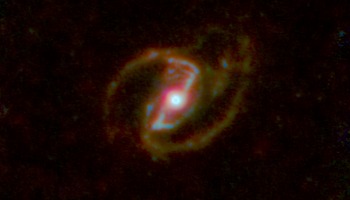
Herschel's View of the Pinwheel Galaxy
This image shows the Pinwheel Galaxy, also known as M101, as viewed by ESA's Herschel Space Observatory. Lying more than 20 million light-years from us, this spiral galaxy is similar in shape to our Milky Way, but it is almost twice as large.
Herschel's observations at far-infrared and sub-millimetre wavelengths reveal the glow of cosmic dust, which is a minor but crucial ingredient in the interstellar material in the galaxys spiral arms. This mixture of gas and dust provides the raw material to produce the galaxy's future generations of stars.
The Pinwheel Galaxy is located in the constellation Ursa Major, the Big Dipper. Thanks to its orientation, we can enjoy a face-on view of the beautiful spiral structure of the galaxy's disc.
The spiral arms are dotted with several bright, blue-hued spots of light: these are regions of active star formation, where large numbers of massive stars are being born.
This three-colour image combines Herschel observations at 70 and 100 microns (blue), 160 and 250 microns (green), and 350 and 500 microns (red). North is up and east to the left.
Image Details
- Date
- September 20, 2017
- ID
- nhsc2017-004a
- Type
- Observation
- Credit
- ESA/Herschel/NASA/JPL-Caltech CC BY-SA 3.0 IGO; Acknowledgement: R. Hurt (JPL-Caltech)
Object Details
- Name
- Pinwheel Galaxy
- M101
- Distance
- Lightyears 20,000,000
- Constellation
- Ursa Major
Downloads
Color Mapping
| Telescope | Spectral Band | Color Assigment | Wavelength |
|---|---|---|---|
| Herschel (PACS) | Infrared | Blue | 70.0 µm |
| Herschel (PACS) | Infrared | Blue | 100.0 µm |
| Herschel (PACS) | Infrared | Green | 160.0 µm |
| Herschel (SPIRE) | Infrared | Green | 250.0 µm |
| Herschel (SPIRE) | Infrared | Red | 350.0 µm |
| Herschel (SPIRE) | Infrared | Red | 500.0 µm |










